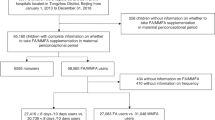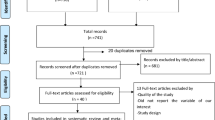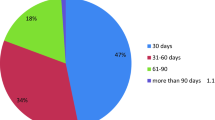Abstract
Background/Objectives:
The incidence of neural tube defects (NTDs) in Ireland has increased in recent years. This study examines knowledge about folic acid (FA) supplementation for the prevention of NTDs among women presenting for antenatal care.
Subjects/Methods:
Women were recruited at their convenience in the first trimester after sonographic confirmation of an ongoing singleton pregnancy. A detailed questionnaire was completed under the supervision of a research dietitian. Clinical and socio-demographic details were collected.
Results:
Of the 587 women studied, 96% took FA during early pregnancy. Of these, 56.4% cited brain/spinal development or the prevention of brain/spinal defects, spina bifida or NTDs as the reason for taking FA. Multivariate analysis showed that women who were experiencing material deprivation or who were living in Ireland <5 years were least likely to be knowledgeable about the benefits of FA supplementation (P<0.05 for both). Over half (57.1%) of the women did not take FA preconceptionally. The main reason reported for not supplementing preconceptionally was that the woman did not expect to get pregnant (76.4%). Over one-third of women (35%), however, reported that they did not know they needed to take FA before becoming pregnant.
Conclusions:
These results highlight the need for a renewed public health campaign in Ireland about the importance of FA. As well as focusing on women who have recently come to live in Ireland, this campaign needs focus on women living in deprivation, as these are the women most at risk of having inadequate knowledge about the importance of FA in improving pregnancy outcomes.
This is a preview of subscription content, access via your institution
Access options
Subscribe to this journal
Receive 12 print issues and online access
$259.00 per year
only $21.58 per issue
Buy this article
- Purchase on Springer Link
- Instant access to full article PDF
Prices may be subject to local taxes which are calculated during checkout
Similar content being viewed by others
References
Czeizel A, Dudas I . Prevention of the first occurrences of neural tube defects by periconceptional vitamin supplementation. N Engl J Med 1992; 327: 1832–1835.
Medical Research Council Vitamin Study Research Group. Prevention of neural tube defects: results of the Medical Research Council Vitamin Study. Lancet 1991; 338: 131–137.
Food Safety Authority of Ireland Report of the National Committee on Folic Acid Food Fortification. FSAI: Dublin, Ireland, 2006.
Mc Donnell R, Delaney V, O’Mahony MT, Mullaney C, Lee B, Turner MJ . Neural tube defects in the Republic of Ireland in 2009-11. J Public Health 2014; 37: 57–63.
Cawley S, Mullaney L, McKeating A, Farren M, McCartney D, Turner MJ . An analysis of FA supplementation in women presenting for antenatal care. J Public Health 2016; 38: 122–129.
Crider KS, Devine O, Hao L, Dowling NF, Li S, Molloy AM et al. Population of red blood cell folate concentration for prevention of neural tube defects: Bayesian model. BMJ 2014; 349: g4554.
Lamers Y, Prinz-Langenohl R, Bramswig S, Pietrzik K . Red blood cell folate concentrations increase more after supplementation with [6S]-5methyl tetrahydrafolae than with folic acid in women of childbearing age. Am J Clin Nutr 2006; 84: 156–161.
Norsworthy B, Skeaff CM, Adank C, Green TJ . Effects of once-a-week or daily folic acid supplementation on red blood cell folate concentrations in women. Eur J Clin Nutr 2004; 58: 548–554.
Hurthouse NA, Gray AR, Miller JC, Rose MC, Houghton LA . Folate status of reproductive age women and neural tube defect risk- the effect of long term folic acid supplementation at doses of 140 μg and 400 μg per day. Nutrients 2011; 3: 49–62.
McKeating A, Crosby DA, Collins M, O'Higgins A, McMahon L, Turner MJ . A longitudinal study of unplanned pregnancy in a maternity hospital setting. Int J Gynecol Obstet 2015; 128: 106–109.
Cawley S, Mullaney L, McKeating A, Farren M, McCartney D, Turner MJ . A review of European guidelines on periconceptional folic acid supplementation. Eur J Clin Nutr 2015; 70: 143–154.
Stamm RA, Houghton LA . Nutrient intake values for folate during pregnancy and lactation vary widely around the world. Nutrients 2013; 5: 3920–3947.
Central Statistics Office EU Survey on Income and Living Conditions (EU-SILC) 2011 and Revised 2010 Results. Central Statistics Office: Dublin, Ireland, 2013.
European Commission Working Group - Statistics on Income Poverty and Social Exclusion Laekenindictaors Detailed Calculation Methodology. Luxembourg: Quetelet Room, Bech Building, 2003. Available at http://www.cso.ie/en/media/csoie/eusilc/documents/Laeken,Indicators,-calculationalgorithm.pdf (last accessed 8 January 2014).
Coombe Women and Infants University Hospital. Annual Clinical Report. HSE Print and Design: Dublin, 2013.
Paudel P, Wing K, Silpakear SK . Awareness of periconceptional folic acid supplementation among Nepal women of child bearing age: a cross sectional study. Prev Med 2012; 55: 511–513.
Al Hakeem MMK . Impact of education on knowledge and se of FA among Sausi women. Pak J Med Sci 2012; 28: 686–690.
Sayers GM, Hughes N, Scallan E, Johnson Z . A survey for knowledge and use of FA among women of child bearing age in Dublin. J Public Health Med 1997; 19: 328–22.
Ward M, Hutton J, Mc Donnell R, Bachir N, Scallan E, O'Leary M et al. Folic acid supplements to prevent neural tube defects: trends in east of Ireland 1996-2002. Ir J Med Sci 2005; 97: 274–276.
Health Pricing Office & Health Service Executive. Perinatal Statistics Report 2013. Health Service Executive: Dublin, 2014.
Liang H, Duan M, Zhou SF, Li X . Knowledge and use of FA for birth defect prevention among women of childbearing age in Shanghai, China. A prospective cross-sectional study. Med Sci Monit 2011; 17: 87–92.
Gjergia R, Stipolier F, Hafiner T, Tezak N, Luzar-Stiffler V . Knowledge and use of folic acid in croatioan pregnant women – a need for health care initiative. Reprod Toxicol 2006; 21: 16–20.
de Jong-van den Berg LTW, Hernandez-Diaz S, Werler MM, Louik C, Mitchell AA . Trends and predictors of folic acid awareness and periconceptional use in pregnant women. Am J Obstet Gynecol 2005; 192: 121–128.
Variyam JN, Baylock J, Smallwood JM . Modelling nutrition knowledge attitudes, and diet-disease awareness: the case of dietary fibre. Stat Med 1996; 15: 23–35.
McCartney DM, Younger KM, Walsh J, O'Neill M, Sheridan C, Kearney JM . Socio-economic differences in food group and nutrient intakes among young women in Ireland. Br J Nutr 2013; 110: 2084–2097.
Dalveit AK, Vollset SE, Lande B, Øien H . Changes in knowledge and attitudes of folate and use of dietary supplements among women of reproductive age in Norway 1998-2000. Scand J Public Heath 2004; 32: 264–271.
Bowling A . The mode of questionnaire administration can have serious effects on data quality. J Public Health 2005; 27: 281–291.
Fattah C, Farah N, O'Toole F, Barry S, Stuart B, Turner MJ . Body Mass Index (BMI) in women booking for antenatal care: comparison between selfreported and digital measurements. Eur J Obstet Gynecol Reprod Biol 2009; 144: 32–34.
Acknowledgements
We thank the pregnant women who participated in this study. We also thank our midwifery colleagues Ms Ruth Harley and Ms Muireann Ni Mhurchu who assisted in the recruitment of women for this study. This work was supported by Safefood.
Author information
Authors and Affiliations
Corresponding author
Ethics declarations
Competing interests
The authors declare no conflict of interest.
Rights and permissions
About this article
Cite this article
Cawley, S., Mullaney, L., McKeating, A. et al. Knowledge about folic acid supplementation in women presenting for antenatal care. Eur J Clin Nutr 70, 1285–1290 (2016). https://doi.org/10.1038/ejcn.2016.104
Received:
Revised:
Accepted:
Published:
Issue Date:
DOI: https://doi.org/10.1038/ejcn.2016.104



